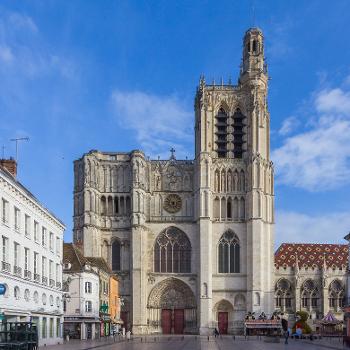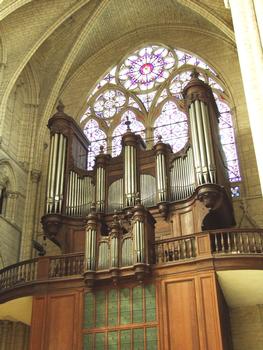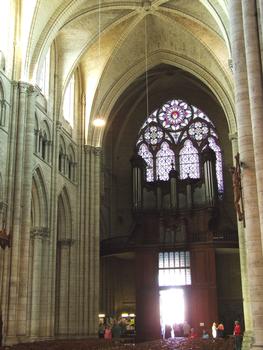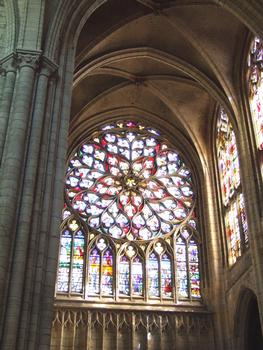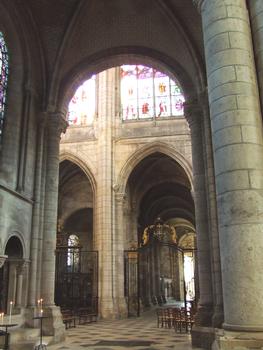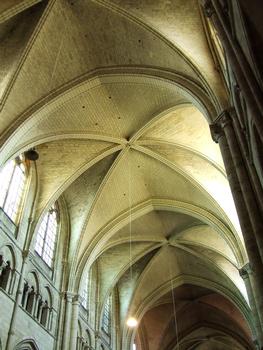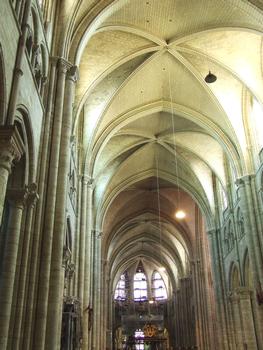General Information
| Name in local language: | Cathédrale Saint-Étienne |
|---|---|
| Beginning of works: | 1130 |
| Completion: | 1513 |
| Status: | in use |
Project Type
| Structure: |
Rib vault |
|---|---|
| Function / usage: |
Cathedral |
| Material: |
Masonry structure |
Awards and Distinctions
| 1840 |
for registered users |
|---|
Location
| Location: |
Sens, Yonne (89), Bourgogne-Franche-Comté, France |
|---|---|
| Coordinates: | 48° 11' 52" N 3° 17' 1" E |
Technical Information
Dimensions
| interior length | 113.50 m | |
| exterior length | 122 m | |
| nave | width | 27.50 m |
| height | 24.40 m | |
| width of central aisle | 15.25 m | |
| South tower | height | 78 m |
| western façade | width | 48.5 m |
| transept | ||
|---|---|---|
| interior length | 48 m | |
| roses | diameter | 11 m |
Materials
| arches |
stone
|
|---|---|
| columns |
stone
|
| walls |
stone
|
| vault |
stone
|
Excerpt from Wikipedia
Sens Cathedral (French:Cathédrale Saint-Étienne de Sens) is a Catholic cathedral in Sens in Burgundy, eastern France. The cathedral, dedicated to Saint Stephen, is the seat of the Archbishop of Sens.
Sens was the first Cathedral to be built in the Gothic architectural style (the Basilica of Saint Denis, the other pioneer Gothic building built at about the same time, was an Abbey, not a cathedral). The choir was begun between 1135 and 1140. The sanctuary was consecrated in 1164, but work continued until 1176. It is a national monument of France. The structure was finally completed in the 16th century. The architecture of its choir influenced, through the architect William of Sens, that of the choir of Canterbury Cathedral.
Description
Sens was a place of considerable importance in the 12th century, seat of the "Primate of Gaul" and superior to the bishopric of Paris. The cathedral church was therefore built on a large scale according to the latest principles. Sens' nave is unusually wide, and the church is larger in overall scale than its contemporaries at Saint Denis, Noyon or Senlis. As is typical with early gothic architecture, the vaulting is sexpartite, surmounting a modest clerestory, with alternating piers and columns between bays. Sens may have been the first church to be completely vaulted in this manner. A gallery opens into the roof space between the aisle arcade and the clerestory. The interior elevation resembles that of Le Mans, but with less massive walls. Flying buttresses were originally employed on the outside, but were replaced with new ones in the thirteenth century. Sens did not initially have transepts; these were only completed between 1490 and 1518 by Martin Chambiges in the Flamboyant Gothic style.
Sculpture and decoration
The west front is pierced by three portals. That in the middle has sculptures representing the Parable of the Ten Virgins and the story of St Stephen. The right-hand portal contains twenty-two statuettes of the prophets, which have suffered considerable damage. Above this portal rises the stone tower, decorated with armorial bearings and with statues representing the principal benefactors of the church. The bells in the campanile by which the tower is surmounted enjoyed immense reputation in the Middle Ages; the two which still remain, La Savinienne and La Potentienne, weigh respectively 15.3 tons and 13.8 tons. The left portal is adorned with two bas-reliefs, Liberality and Avarice, as well as with the story of John the Baptist. The portal on the north side of the cathedral is one of the finest examples of French 16th-century sculpture. That on the south side is surmounted by a magnificent stained-glass window. Other have rounded shape design as clock is represented, tiny miniature designs on sculpture had been embedded on metal parts of the church. Other windows of the 12th to the 16th century are preserved, some of them representing the legend of Thomas Becket of Canterbury.
Among the interior features are the tomb of Louis, Dauphin of France (son of Louis XV) and his consort, Marie-Josèphe of Saxony, one of the works of Guillaume Coustou the Younger, and bas-reliefs representing scenes from the life of Cardinal Antoine Duprat, chancellor of France and archbishop of Sens from 1525 to 1535. The mausoleum from which they came was destroyed in the French Revolution.
The cathedral treasury, one of the richest in antiquities in France, contains a purported fragment of the true cross presented by Charlemagne, and the vestments of Thomas Becket. The treasury is now kept at a museum.
It was in the cathedral of Sens that St Louis, in 1234, married Marguerite of Provence, and five years later deposited the crown of thorns.
Text imported from Wikipedia article "Sens Cathedral" and modified on July 22, 2019 according to the CC-BY-SA 4.0 International license.
Participants
- Martin Chambiges (architect)
- Pierre Ier Chambiges (architect)
- Godinet (architect)
- Nicolas de Chaumes (architect)
Relevant Web Sites
Relevant Publications
- (1972): Art & Architecture in Medieval France. Medieval Architecture, Sculpture, Stained Glass, Manuscripts, the Art of the Church Treasuries. Icon Editions (Harper & Row Publishers), New York (USA), pp. 112-119.
- (1999): La cathédrale en chantier. La construction du transept de Saint-Etienne de Sens d'après les comptes de la fabrique, 1490-1517. Comité des travaux historiques et scientifiques, Paris (France), ISBN 978-2735504183, pp. 667.
- (2012): The Chambiges and the Construction of Vaulted Stone Spiral Starcases. Presented at: Fourth International Congress on Construction History, Paris, 3-7 July 2012, pp. 67-74.
- (1975): The Continuous Plan of Sens Cathedral. In: Journal of the Society of Architectural Historians, v. 34, n. 3 (October 1975), pp. 198-207.
- (1970): The Early Campaign at Sens, 1140-1145. In: Journal of the Society of Architectural Historians, v. 29, n. 2 (May 1970), pp. 97-107.
- About this
data sheet - Structure-ID
20002180 - Published on:
05/11/2001 - Last updated on:
20/02/2023

